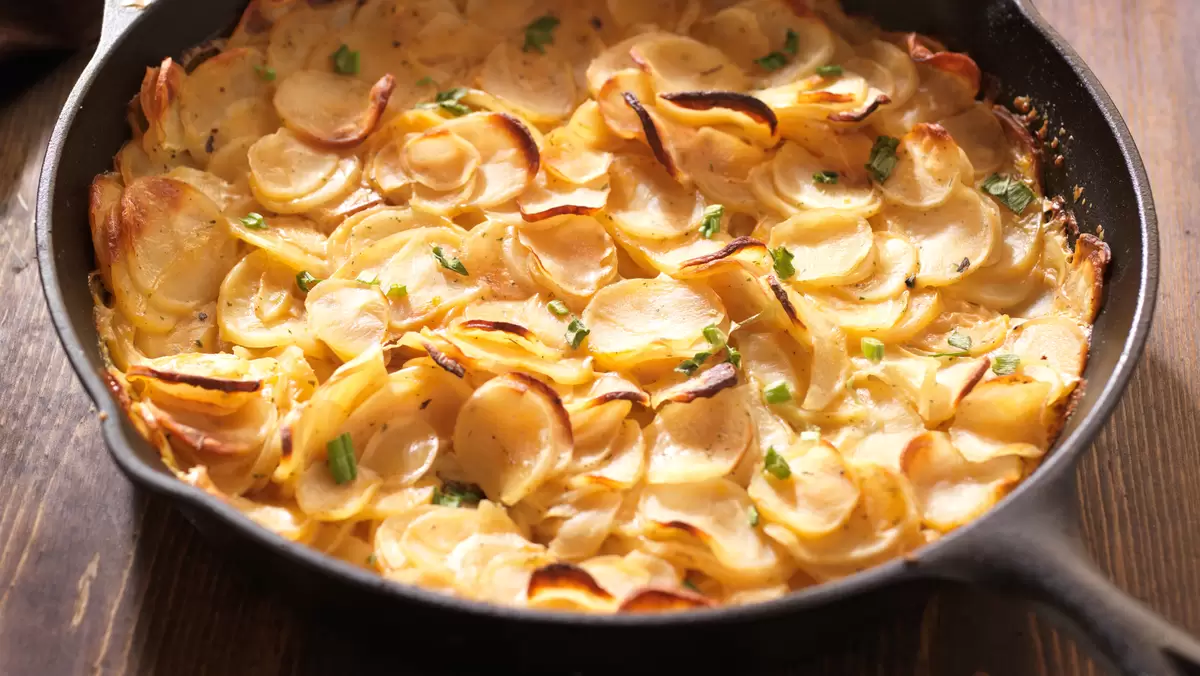Join Our Newsletter
Get our best recipes and health tips delivered right to your inbox!

Need a healthy scalloped potatoes recipe? Try these Heart-Healthy Scalloped Potatoes, a delicious diabetic potatoe casserole baked with layers of tender Yukon gold potatoes and sweet caramelized onions. Finished with unsalted vegetable stock and baked to a golden perfection, this low sodium scalloped potatoes recipe comes in at a low 150 calories in each serving. This is a low-cholesterol potato recipe, too, perfect for healthy family dinners.
Try these delicious heart-healthy side dish recipes, too!
This recipe is designed to be heart-healthy by replacing high-fat ingredients with smarter alternatives. Instead of relying on heavy cream and butter for flavor, it uses a modest amount of olive oil and unsalted vegetable stock to create a tender, flavorful dish. Flavor comes from caramelized onions and fresh herbs, allowing for a significant reduction in sodium without sacrificing taste.
You can make scalloped potatoes healthier by replacing high-fat, high-sodium ingredients. Use unsalted vegetable stock or low-fat milk instead of heavy cream, flavor with herbs and spices instead of excess salt, and use heart-healthy fats like olive oil instead of butter.
Potatoes like Yukon Gold, red, or sweet potatoes are great for a heart-healthy diet. They are rich in potassium, which can help manage blood pressure, and are a good source of fiber. The key is to prepare them without a lot of salt, butter, or cream.
The main difference is cheese. Traditional scalloped potatoes are baked in a creamy sauce (often milk or cream), while potatoes au gratin are made with cheese and often have a topping of cheese or breadcrumbs. This recipe is a variation on scalloped potatoes, using stock instead of cream.
To prevent watery scalloped potatoes, ensure your potato slices are not too thick, as this can prevent them from cooking evenly and absorbing the liquid. Also, allowing the dish to rest for at least 15 minutes after baking lets the starches in the potatoes set, which helps thicken the sauce.
Often misunderstood, potatoes are a fantastic source of essential nutrients like potassium and vitamin C, making them a smart choice for any balanced diet. Their incredible versatility means they can be roasted, mashed, or baked to create the perfect healthy and satisfying side dish for any occasion.
Finding the perfect main dish to complement your heart-healthy scalloped potatoes is easy with these flavorful dinner ideas. The creamy texture and savory flavor of the potatoes pair beautifully with a wide variety of lean proteins, from baked fish and grilled chicken to slow cooked pork tenderloin.
Recipe yields 8 servings
Preheat oven to 400°F. Generously grease a 1.5-quart casserole dish or a large deep cast iron skillet with nonstick cooking spray. Set aside.
In a large sauté pan, heat the olive oil and butter over medium heat. Lower heat to low, add the onions and sprinkle with ⅛-teaspoon salt; cook, stirring frequently, for 45 minutes to 1 hour to caramelize them. Add ½ tablespoon of thyme and garlic about halfway through caramelizing process. When the onions are done, pour them into a fine mesh sieve to drain the oil-butter sauce into a small bowl; set aside.
In a small mixing bowl, combine the remaining thyme, dried sage, black pepper and remaining salt. Spread a layer of potatoes on the bottom of the prepared baking dish, followed by a layer of caramelized onions. Sprinkle with the herb mixture. Continue layering, ending with a layer of potatoes.
Pour the vegetable stock over the top of the potato casserole, followed by the reserved oil-butter sauce. Bake for 50 to 60 minutes, until the top is golden brown and the potatoes are crispy around the edges. Allow to rest for 15 minutes. Serve warm and enjoy!
If you are not strictly dairy-free, you can substitute half of the vegetable stock with an equal amount of low-fat milk or evaporated skim milk for a creamier result.
For a tangy, creamy alternative, you can whisk ½ cup of plain, non-fat Greek yogurt into the warm vegetable stock before pouring it over the potatoes. Do not boil the yogurt.
To make this a main course, add a layer of thinly sliced, low-sodium cooked ham or chicken between the potato layers.
For a cheesy flavor without the fat and sodium, sprinkle one to two tablespoons of nutritional yeast between the layers along with the herb mixture.